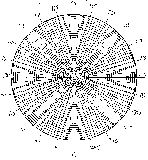High School Mathematics Problems from Alaska
A database
of lessons and units searchable by content and cultural standards,
cultural region and grade level. More units will be available soon.
You can use Acrobat Reader to look at the PDF version of the Cover
Sheet
for the Units and Self-Assessment
for Cultural Standards in Practice.
Azimuth
and Arc Length
(Problem Two)
James H. Grey
jgrey@northstar.k12.ak.us
MS
Word Download
Standards:
Measurement,
Estimation and Computation, Functions and Relationships, Geometry,
Statistics/Probability.
Performance
Standards: A2.4.3,
A3.4.1, A4.3.1, A5.4.1, A5.4.2, A5.4.7, A6.3.1, A6.4.1
Concepts:
Angle Measure,
Azimuth, and Arc Length.
Carnegie
Chapter: No
corresponding problem.
Overview:
Focusing on
making visual representations of geometric data.
Teacher
Notes:
Before doing this activity, I suggest having an anticipatory-set
discussion with your students regarding where the sun rises and sets
at different times of the year. Some leading questions and
discovery-based dialogue will help with this set of problems.
Azimuth and Arc
Length
Problem Two
The directions on a compass
correspond to numbers from 0-360 as shown below, where North corresponds to
0 degrees, East is 90 degrees, South is 180 degrees, and West is 270 degrees.
This is known as azimuth. If an object is at an azimuth of 45 degrees, it is
in the Northeast direction relative to an observer.

The sun rises for
the first time of the year in Barrow, Alaska on January 23. It rises
(comes above the horizon) at an azimuth of 174.3 degrees and sets
(goes below the horizon) at an azimuth of 185.9 degrees.
Write your answers
to the following questions in the form of complete sentences.
1a. In
what part of the sky, or in what direction does the sun first
rise?
b.
Where does it set?
2a. What
is the mean of the sunrise and sunset azimuth?
b. What
direction is it?
c.
Explain why these answers might be surprising to some
people.
Activity:
- Find
the wall of your classroom that most closely faces south. Put a
sign on it labeling it 180 degrees. Label the other three walls
accordingly.
- Holding a
protractor in a fixed position away from all four walls, run
string lines from it every ten degrees toward the wall and label
the wall accordingly. (Teacher note: It’s suggested that
students make signs for every ten degrees that are large enough to
be seen from any part of the room. Each sign should also have a
mark to denote the position of the angle.) Viewed from above, your
classroom will look something like this:

South
Wall
- Using
a piece of colored yarn, tape the arc that the sun travels from
its sunrise to sunset on January 23.
- Using
additional pieces of yarn and the table below, attach a piece to
the wall for every-other day’s arc being sure to
attach each end at the appropriate azimuth. (Teacher note:
Labeling every day makes the wall look too "busy" and this may
lead to confusion.) Label the day’s arc.
|
Date
|
Day
|
Azimuth
(Rise/Set)
|
Date
|
Day
|
Azimuth
(Rise/Set)
|
|
Jan
23
|
23
|
174.3-185.9
|
Jan
28
|
28
|
158.6-201.5
|
|
Jan
24
|
24
|
169.5-190.8
|
Jan
29
|
29
|
156.6-203.6
|
|
Jan
25
|
25
|
165.9-194.0
|
Jan
30
|
30
|
154.7-205.5
|
|
Jan
26
|
26
|
163.2-196.8
|
Jan
31
|
31
|
152.7-207.4
|
|
Jan
27
|
27
|
160.8-199.4
|
Feb
1
|
32
|
151.0-209.3
|
- Describe
the impression you have of the arc that the sun covers each
day.
4a. Using the
attached polar coordinate graph paper and colored pencils, draw the
arc for every-other day in the table below. Begin with the
shortest arc closest to the center of the circle.
|
Date
|
Day
|
Azimuth
(Rise/Set)
|
Date
|
Day
|
Azimuth
(Rise/Set)
|
|
March
16
|
75
|
93.2-267.5
|
March
22
|
81
|
85.7-274.9
|
|
March
17
|
76
|
91.9-268.7
|
March
23
|
82
|
84.5-276.3
|
|
March
18
|
77
|
90.7-270.1
|
March
24
|
83
|
83.2-277.4
|
|
March
19
|
78
|
89.4-271.2
|
March
25
|
84
|
82.0-278.6
|
|
March
20
|
79
|
88.2-272.4
|
March
26
|
85
|
80.8-279.9
|
|
March
21
|
80
|
87.0-273.7
|
|
|
|
- Explain
the difference between the information on the graph and the
information on the wall, from part three.
- Why do
you think that it is different?

Click on image for a
larger view
Table of
Contents
For the Teacher's Guides, please email Alaska
Native Knowledge Network
Handbook
for Culturally Responsive Science Curriculum by Sidney Stephens
Excerpt: "The information and insights contained in this document will be
of interest to anyone involved in bringing local knowledge to bear in school
curriculum. Drawing upon the efforts of many people over a period of several
years, Sidney Stephens has managed to distill and synthesize the critical ingredients
for making the teaching of science relevant and meaningful in culturally adaptable
ways." |